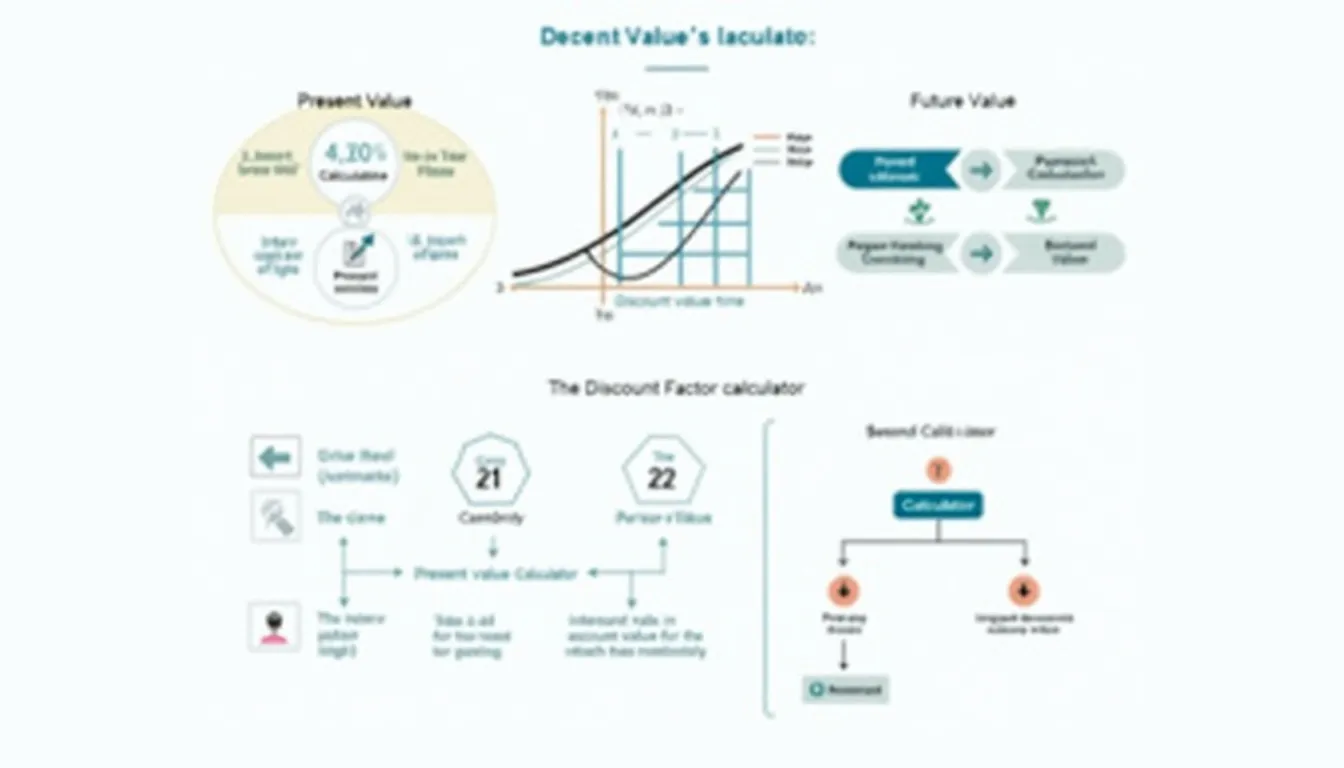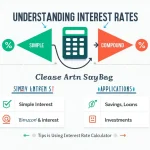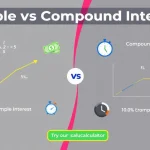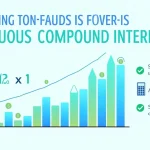Discount Factor Calculator
Is this tool helpful?
In the world of finance and investment, understanding the time value of money is crucial. One of the most powerful tools for this purpose is the Discount Factor Calculator. This article will dive deep into the intricacies of this invaluable financial instrument, exploring its uses, benefits, and practical applications.
How to Use the Discount Factor Calculator Effectively
The Discount Factor Calculator is a user-friendly tool designed to help you calculate the present value of future cash flows. Here’s a step-by-step guide on how to use it effectively:
- Enter the Interest Rate: Input the interest rate as a percentage. This could be the market interest rate, your required rate of return, or any other relevant rate.
- Specify the Time Period: Enter the number of days for which you want to calculate the discount factor.
- Input the Future Value: Enter the amount of money you expect to receive in the future.
- Choose the Calculation Type: Select between simple interest, compound interest, or continuously compounded interest, depending on your specific scenario.
- Click “Calculate”: The calculator will then provide you with the discount factor and the present value of your future cash flow.
By following these steps, you can quickly and accurately determine the present value of future money, an essential skill in financial planning and investment analysis.
Understanding the Discount Factor: Definition, Purpose, and Benefits
The discount factor is a multiplier used in financial calculations to determine the present value of future cash flows. It’s based on the principle that money available now is worth more than the same amount in the future due to its potential earning capacity.
Definition of Discount Factor
Mathematically, the discount factor is represented as:
$$ \text{Discount Factor} = \frac{1}{(1 + r)^t} $$Where ‘r’ is the discount rate (or interest rate) and ‘t’ is the time period.
Purpose of the Discount Factor
The primary purpose of the discount factor is to adjust future cash flows to their present value, allowing for more accurate financial comparisons and decision-making. It’s an essential component in various financial calculations, including:
- Net Present Value (NPV) analysis
- Bond pricing
- Investment appraisal
- Retirement planning
- Real estate valuation
Benefits of Using a Discount Factor Calculator
- Accuracy: It eliminates human error in complex calculations.
- Time-saving: It provides instant results, allowing for quick decision-making.
- Flexibility: It can handle different types of interest calculations (simple, compound, continuous).
- Consistency: It ensures all calculations are performed using the same methodology.
- Accessibility: It’s available online, making it easy to use anywhere, anytime.
Addressing User Needs: How the Discount Factor Calculator Solves Financial Challenges
The Discount Factor Calculator is designed to address several key financial challenges:
1. Time Value of Money Calculations
One of the fundamental principles of finance is that money’s value changes over time. The calculator helps users quantify this change, allowing for more informed financial decisions.
2. Investment Comparison
By converting future values to present values, the calculator enables fair comparison between different investment opportunities, even if they have different time horizons.
3. Risk Assessment
The discount rate often incorporates a risk premium. By adjusting this rate, users can assess how different risk levels affect the present value of future cash flows.
4. Financial Planning
Whether it’s for retirement, education, or any other long-term goal, the calculator helps in determining how much should be saved now to reach a specific future financial target.
5. Bond Valuation
For fixed income investors, the calculator is crucial in determining the fair value of bonds by discounting future coupon payments and the face value to the present.
Practical Applications: Real-World Examples of the Discount Factor Calculator in Action
Let’s explore some practical scenarios where the Discount Factor Calculator proves invaluable:
Example 1: Retirement Planning
Imagine you’re 30 years old and want to have $1,000,000 when you retire at 65. Assuming an annual interest rate of 7% (compounded annually), you can use the calculator to determine the present value of this future sum:
- Interest Rate: 7%
- Time Period: 35 years (12775 days)
- Future Value: $1,000,000
- Calculation Type: Compound Interest
The calculator would show that the present value is approximately $131,367. This means if you invest $131,367 today at 7% annual interest, it would grow to $1,000,000 in 35 years.
Example 2: Real Estate Investment
Suppose you’re considering purchasing a rental property that’s expected to generate $20,000 in annual income for the next 10 years, after which you plan to sell it for $300,000. If your required rate of return is 8% (considering the risks involved), you can use the calculator to determine the property’s present value:
- For each year’s rental income:
- Interest Rate: 8%
- Time Period: 365 to 3650 days (for years 1 to 10)
- Future Value: $20,000
- Calculation Type: Compound Interest
- For the sale price:
- Interest Rate: 8%
- Time Period: 3650 days
- Future Value: $300,000
- Calculation Type: Compound Interest
By summing up the present values of all these cash flows, you get the total present value of the investment, which you can compare with the asking price to decide if it’s a good investment.
Example 3: Bond Valuation
Let’s say you’re considering purchasing a 5-year bond with a face value of $1000 that pays a 4% annual coupon. If the market interest rate is 5%, you can use the calculator to determine the bond’s fair value:
- For each coupon payment:
- Interest Rate: 5%
- Time Period: 365 to 1825 days (for years 1 to 5)
- Future Value: $40 (4% of $1000)
- Calculation Type: Compound Interest
- For the face value:
- Interest Rate: 5%
- Time Period: 1825 days
- Future Value: $1000
- Calculation Type: Compound Interest
The sum of these present values would give you the fair value of the bond, which you can compare with its market price to determine if it’s overvalued or undervalued.
Frequently Asked Questions about the Discount Factor Calculator
1. What is the difference between simple interest, compound interest, and continuous compounding?
Simple interest is calculated only on the principal amount. Compound interest is calculated on the principal and the accumulated interest from previous periods. Continuous compounding assumes interest is calculated and added to the principal continuously.
2. How does the discount factor relate to the time value of money?
The discount factor quantifies the time value of money by providing a multiplier that converts future value to present value, accounting for the opportunity cost of money over time.
3. Can the calculator be used for periods shorter than a day?
While the calculator uses days as the smallest unit, for very short-term calculations (less than a day), you can input the time as a fraction of a day (e.g., 0.5 for 12 hours).
4. How do I choose the appropriate interest rate?
The interest rate should reflect your opportunity cost of capital. This could be the return you could get from a risk-free investment (like government bonds) plus a risk premium based on the investment’s risk level.
5. Can the calculator handle negative interest rates?
Yes, the calculator can handle negative interest rates, which might occur in certain economic conditions or for specific financial instruments.
Conclusion: Harnessing the Power of the Discount Factor Calculator
The Discount Factor Calculator is more than just a financial tool – it’s a gateway to smarter, more informed financial decision-making. By allowing you to quickly and accurately determine the present value of future cash flows, it empowers you to:
- Make more accurate investment comparisons
- Plan more effectively for long-term financial goals
- Assess the true value of financial instruments like bonds
- Understand and quantify the time value of money in various scenarios
Whether you’re a financial professional, a student of finance, or simply someone looking to make smarter financial decisions, the Discount Factor Calculator is an invaluable asset in your financial toolkit.
We encourage you to explore the calculator, experiment with different scenarios, and see for yourself how it can enhance your financial analysis and decision-making processes. Remember, in the world of finance, knowledge is power – and the Discount Factor Calculator puts that power at your fingertips.
Start using the Discount Factor Calculator today and take the first step towards more informed, confident financial decisions!
Important Disclaimer
The calculations, results, and content provided by our tools are not guaranteed to be accurate, complete, or reliable. Users are responsible for verifying and interpreting the results. Our content and tools may contain errors, biases, or inconsistencies. We reserve the right to save inputs and outputs from our tools for the purposes of error debugging, bias identification, and performance improvement. External companies providing AI models used in our tools may also save and process data in accordance with their own policies. By using our tools, you consent to this data collection and processing. We reserve the right to limit the usage of our tools based on current usability factors. By using our tools, you acknowledge that you have read, understood, and agreed to this disclaimer. You accept the inherent risks and limitations associated with the use of our tools and services.







